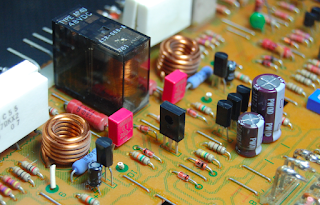Today Im show casing a Pioneer SX-3900 Receiver that came in for a restoration. The SX-3900 is one of the most popular Pioneer’s today still, being the bigger brother to SX-3800 series and sharing very similar topology. The SX-3900 was released from 1980-1981 as part of the Fluoroscan receivers featuring analog and digital circuits. This particular unit also came in with a host failures.
(Audio Nulled, Meters only :)
Power Supply AWR-210 & JFET Modifications
The SX-3900 uses a similar device, a N-JFET 2SK34 device to establish the current drive for the rails. These commonly fail with catastrophic damages to the PCB and circuit. The SX-3900 also emits a large mount of heat form the TO-220 regulators on board. During this stage new 15,000MFD filter capacitors and the soft start stage had a new Omron Low noise relay and X1Y2 Vishay 1Kv Safety capacitors installed.
As you can below, the original PCB had heavy dried glue debris from the large vertical mounted components spread to most components. This should be cleaned and removed and effected component tests and or replaced.
All of the transistor devices were replaced including the TO-220 mounted and unmounted 2SB/2SD devices to a more robust, heavy duty On-Semi TO-220 MJE device, with new thermal compound applied. Remaining devices were all replaced with a low noise Fairchild TO-92 and TO-126 compliments. (SEE JFET MOD INFO BELOW)
All of the electrolytic were replaced with a high temp (105C) low impedance Nichicon PW with an increase in operating voltages. Associated resistors were replaced with KOA 1/2Watt carbon film resistors due to failure of the circuit. Diodes were replaced with modern Fairchild axial 4148 type.
BEFORE
AFTER
2SK34 JFET Modification
To develop the current source for the power supply rails a N-Channel 2SK34 JFET device is used, unfortunately these have a high failure rate. These are most commonly see also in the SX-1980 Pioneer power supplies.
2SK34 Curve Test Report
Due to limited space the form-factor must be as small as possible, yet logically laid out and aesthetically pleasing. Determine the voltage drop of the LED’s subtracted by the Vbe drop and divided over the pairs of emitter resistors for approximately 2-2.2mA source
Its a very tight fit, its important not to rest on a nearby device or the TO-220 heatsinks.
JFET MOD in action! (cool green glow :)
Driver (& Protection) AWH-097
The SX-3900 utilizes a unique Non-Switching-Amplifier (NSA) circuit design for the amplifier stage. The SX-3900 driver stage is comprised on an initial PNP/NPN differential PP gain stage with a constant current source to a darlington pre-driver and finally a 2-stage SEPP darlington output stage define by a High Speed Bias Servocontrol circuit designed by Pioneer. This particular assembly had significant faults. A failed PNP driver, failed tied emitter resistors, open resistors and several failed general diodes along with a NPN/PNP output failure. This is not an uncommon failure of the SX-3900 or SX-3800 series.
The initial differential pairs are comprised on a twin transistor compliment 2SA979 and 2SC2291, these twin packages tend to exhibit failure rates and transient noise potential. I prefer, though time consuming, to replace these with separate, 1% matched transistors. In the graph below I demonstrate on a curve tracer (new addition to the shop!!) the BETA mapping vs the new devices. Note with the new devices we have obtained a 1% or better BETA match with the new low noise TO-92 Fairchild devices. Both NPN/PNP compliment were replaced in this manner.
2SA979 & KSA992 BETA MAPPING COMPARISON
All of the transistors were replaced with a low noise Fairchild TO-92 and TO-126 devices including all compliments. Diodes were replaced with modern Fairchild axial 4148 diodes. All 6 pots were replaced with precision Bourns potentiometers. A sourced from europe NOS relay (48V) was installed for the protection. The .082 film were upgrade to .1MFD high grade WIMA polypropylene film capacitors. Electrolytic’s were replaced with high temp (105C) low impedance Nichicon PW and VP Bipolar (.22MFD) capacitors with an increase in operating voltages.
BEFORE
AFTER
OUTPUT Device Comparison
Due to the failure highlighted above, new output devices were selected using heavy duty, low distortion OnSemi devices. Below is a comparison of the Beta/performance of the original/ SX-3900 (EURO OUTPUTS) and newer OnSemi MJ TO-264 devices.
Failed Driver Array
OUTPUTs Compared
Tone GWG-140
The SX-3900 uses a series of HA12017 pre-amplifier gain IC’s for the differential and gain stage with separate tone control actions. A linear NFB response curve is achievable with the tone Off function.
All of the low value capacitors were replaced with a high grade WIMA and Panasonic ECQ (.33MFD) polypropylene film capacitors as well as audio grade Nichicon KT capacitors for the remainder with an increase in operating voltages.
BEFORE
AFTER
RIAA EQ AWM-226
The Phono stage is designed around high voltage gain SEPP design capable of -86dB SN Ratio and overload up to (300mV .005%) which is quite impressive.
All of the small signal devices were replaced with modern low noise low distortion TO-92 and TO-126 fairchild devices. Capacitors were replaced with a low impedance Nichicon PW and audio grade KT capacitors with an increase in operating voltages.
BEFORE
AFTER
Fluoroscan Indicator AWV-008
A common complain with SX-3800/3900 owners are dim or absent displays, this is commonly due to poor grade electrolytic used for the fabrication of the receivers, I am unsure if this is consistent throughout serial numbers or not.
All of the electrolytics were replaced with a high temp low impedance (105C) Nichicon PW capacitors with an increase in operating voltages. 1MFD< capacitors were all replaced with high reliability WIMA polypropylene film capacitors.
BEFORE
AFTER
New custom SMD LED' in Warm White
Audio Notizen













































Off the chain your attention to detail is unparalleled. It sure is fun looking at the transformation, (and reading things I don't understand!)
ReplyDeleteVery excellent work! Interested in restoring another? Mine looks new but has distortion issues. Thanks.... Darryl. Dwmuck at chartertn.net
ReplyDelete